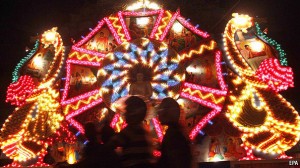Let the army make it next time
In bigger barracks
2 JUNE 2011: IN THE run-up to Vesak, the holiest day in the Buddhist calendar, which this year coincided with the second anniversary of its  victory against the Tamil Tiger rebels, Sri Lanka’s armed forces had plenty to do. The throngs who clogged Colombo’s streets on May 18th for the festival of light marking the Buddha’s birthday were treated to an array of glimmering, white paper lanterns, each meticulously assembled by a soldier, sailor or airman.
victory against the Tamil Tiger rebels, Sri Lanka’s armed forces had plenty to do. The throngs who clogged Colombo’s streets on May 18th for the festival of light marking the Buddha’s birthday were treated to an array of glimmering, white paper lanterns, each meticulously assembled by a soldier, sailor or airman.
The army’s non-martial tasks do not stop at lamp-making. Between 2006 and 2009 Sri Lanka inducted thousands into its army, navy and air force to fight against the Liberation Tigers of Tamil Eelam. With the war won, servicemen are being deployed in everything from market gardening to tourism.
The bloody end of the war is still being refought diplomatically. On May 27th Sri Lanka celebrated it with a military parade in Colombo featuring mostly Chinese, Ukrainian and Russian hardware. And on May 31st a three-day seminar opened in Colombo, with the aim of teaching the world how to defeat terrorism the Sri Lankan way. Meanwhile, in Geneva, at the United Nations Human Rights Council, a UN special investigator was showing video of Sri Lankan soldiers in the war’s final days, apparently executing civilians. He called it “trophy footage” and evidence of serious human-rights abuses. However, despite calls for a boycott of the Sri Lankan seminar, 42 countries attended.
A notable omission from the agenda was any initiative to pare back Sri Lanka’s now bloated armed forces. Instead, the government is finding new things for them to do. Soldiers are taking on the civilian middlemen who control the vegetable trade by selling cheap produce, some of it from military farms. The navy has even opened a vegetable shop near one of its biggest camps in Colombo. The army has an air-ticketing agency. It is building roads and bridges, and houses for the internally displaced. Soldiers built one cricket stadium and renovated another for the World Cup earlier this year. Restaurants along the highway to Jaffna in the north are mostly army-owned or -run. The army will even supervise the private companies that collect the rubbish in Colombo.
On the Jaffna Peninsula the army converted a former officers’ mess into a 22-room luxury resort. It runs two hotels elsewhere. The navy has a canal-boat service in Colombo; it also offers whale-watching tours. In parts of the country the army in effect runs local government. In the Vanni district, for example, an area populated mainly by the Tamil minority, where hundreds remain displaced or resettled in shoddy shelters, many administrative measures need a military stamp of approval. The governors of the Northern and Eastern provinces are both retired military commanders. Other retired officers are now posted overseas as ambassadors.
A controversial post-war task for the army is to conduct “leadership training” for university students. Despite protests by student unions, and advice to the government from the Supreme Court to consider a postponement, a first batch of 10,000 students has started the compulsory course, conducted in army camps.
Gotabaya Rajapaksa, the defence minister, says the armed forces have tripled in number under his brother, Mahinda, the president. He sees nothing amiss with their deployment in “development work”. The government has a duty, he says, to care for its soldiers, many of whom were recruited in poor, rural areas. Nor is there much public protest against this creeping militarisation.
But NGOs caution against such extensive military involvement in civilian life and question the use of soldiers to fix public-sector failures. Indeed, says the National Peace Council, an NGO, failure to separate military and civilian roles could ultimately lead to “unwanted military rule nursed by a democratically elected government”. When armies get above themselves, nasty things happen.
This is a repeat of an article that appeared June 2, 2011
See original article below
http://www.economist.com/node/18775481
